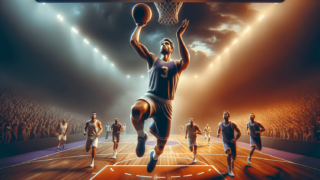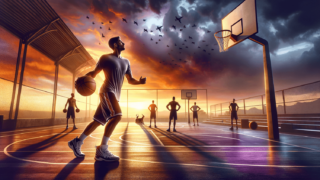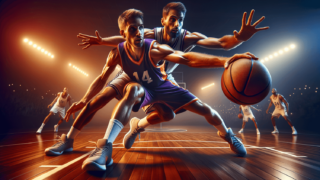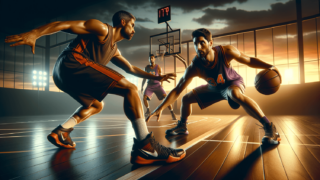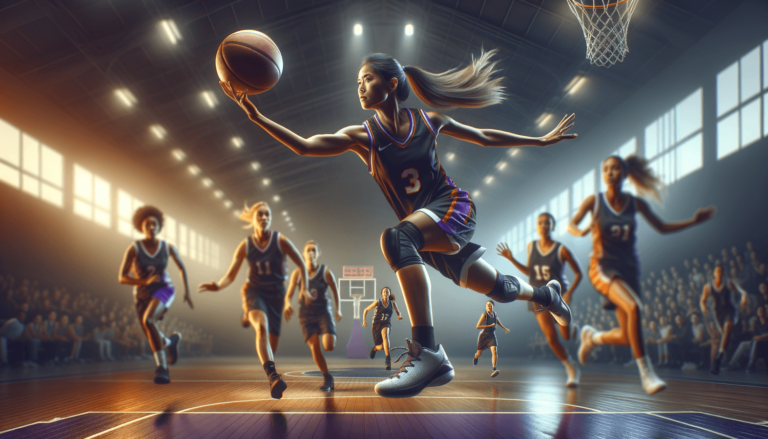
As a crucial part of every winning basketball strategy, passing has the power to elevate a team’s offensive play to new heights, leaving opponents scrambling in a cloud of dust. In this blog post, we’ll explore the art and science of becoming a better passer, arming you with the knowledge and techniques to turn you into a passing maestro. Whether you’re a novice player or a seasoned pro, we have something for you. Get ready to bask in the glory of your teammates’ cheers as your crisp, well-timed passes help secure victory after victory. Let’s dive into the world of basketball passing and reveal the secrets behind this foundational skill!
How to Become a Better Passer in Basketball?
To become a better passer in basketball, focus on improving your court vision, awareness, and decision-making skills. Start by grasping the fundamentals of passing, such as executing chest passes, bounce passes, and overhead passes. Practice accuracy and timing by completing passing drills with a partner or a team. Improve your ball handling to create better passing opportunities, and study your teammates’ movements to anticipate their needs. Lastly, watch and analyze games featuring great passers to learn from their techniques and strategies.
Mastering the Fundamentals of Passing
Becoming a better passer in basketball begins with a solid grasp of the fundamentals. By understanding and practicing various passing techniques, you can develop the versatility required for different game situations.
Chest Passes
The chest pass is a fundamental basketball pass, enabling players to efficiently move the ball across the court. To perform a chest pass, hold the ball with both hands, thumbs behind it, and elbows bent. Step towards your intended target and push the ball outward, snapping your wrists as you release. The pass should follow a straight line without any arc.
Bounce Passes
The bounce pass is another essential passing technique, particularly useful when attempting to dodge defenders. Initiate the bounce pass with a similar grip and mechanics as the chest pass. However, aim at the floor two-thirds of the way to your intended target, allowing the ball to bounce up into your teammate’s hands. Perfecting the right amount of force and angle takes practice.
Overhead Passes
The overhead pass is useful for making long, quick passes over defenders or across the court. To perform an overhead pass, hold the ball over your head with both hands on either side. Step into your target area and release the ball by extending your arms and quickly snapping your wrists.
Improving Accuracy and Timing
Accurate passes and precise timing can drastically impact the success of a given play. To hone these skills, incorporate passing drills into your practice sessions.
Partner Passing Drills
Practicing with a partner enables you to work on your execution, accuracy, and timing simultaneously. Set up various passing scenarios by varying your distance, angle, and the type of pass used. Develop your skills by incorporating more challenging elements, such as dribbling, moving without the ball, and cutting to simulate game situations.
Wall Passing Drills
Wall passing drills are useful for refining accuracy and control while working independently. Set up targets on a wall and practice various types of passes, working on both speed and accuracy. This self-sufficient practice method allows you to focus on the details of your passes without the pressure of team practice sessions.
Boosting Ball Handling Skills
Improving your ball-handling skills can create better passing opportunities and keep defenders guessing. Incorporate dribbling drills to become more comfortable with the ball and enhance your ability to move efficiently around the court.
Two-Ball Dribbling Drills
Dribbling with two balls simultaneously is an excellent way to augment your ball-handling skills while also bolstering your weaker hand. Coordinate bounce patterns, switch balls between hands, and dribble at different heights and tempos to challenge yourself.
Dribbling Obstacle Courses
Design dribbling obstacle courses that mimic different on-court scenarios. This guided practice helps develop control and agility while navigating around defenders. As your skills advance, increase the difficulty by incorporating cones, chairs, or other obstacles.
Enhancing Court Vision and Awareness
A well-rounded passer must possess exceptional court vision and awareness. Focus on improving these skills to anticipate the actions of both teammates and opponents during gameplay.
Work on Peripheral Vision
Expand your peripheral vision by practicing seeing the court with your head up instead of looking directly at the ball. Scanning the floor helps identify teammate movements and available passing lanes. Couple this with dribbling drills to develop your multitasking abilities on the court.
Analyze Game Footage
Study game footage to identify common patterns and situations that lead to successful passes. Overtime, you’ll develop a sense of foresight, noticing how different scenarios play out, allowing you to predict the best methods or angles for your passes.
Empathizing with Teammates
Understanding your teammates’ positioning, tendencies, and preferences are crucial elements of becoming a better passer in basketball. By connecting with your team cohesively, you create a natural synergy on the court.
Communicate and Bond
Forge strong relationships with your teammates to improve on-court communication and collaboration. Through open dialogue, you can discuss strategies, provide feedback, and share suggestions for possible plays. Building trust and rapport enhances your ability to anticipate your teammates’ needs.
Study Teammates’ Preferences
Familiarize yourself with individual teammates’ playing styles and preferences. Observe how they typically move, their preferred shot locations, and their comfort zones. Recognizing these attributes allows for more tailored and effective passes, resulting in smoother gameplay and increased scoring opportunities.
Learning from the Greats
Aspiring to emulate the extraordinary passing abilities showcased by basketball’s greatest players can inspire your progress. Analyze and learn from the best by watching and dissecting their performances.
Study Playmakers
Identify and analyze players known for their exceptional passing skills. Notice details such as their decision-making, timing, and execution. Examples include Magic Johnson, Steve Nash, and Jason Kidd, all of whom exhibit remarkable passing prowess. Learn their techniques and styles and adapt them to suit your own game.
Dissect Highlight Plays
Break down highlight reels, focusing on the timing, positioning, and execution within each passing sequence. By identifying patterns and contextual clues, you can ultimately incorporate those strategies into your gameplay to elevate your passing aptitude.
No journey to basketball excellence is complete without attention to passing. Embrace the fundamentals, refine your accuracy and timing, enhance court vision, and learn from the legends to become a passing virtuoso. Stay attentive and committed in your pursuit of improvement, and soon, you’ll witness the sweet harmony of teamwork on the court.
Developing Decision-Making Skills
In addition to technical skills and court awareness, becoming a better initiator of flowing gameplay requires adept decision-making skills. Enhance your ability to make split-second choices by refining your understanding of various aspects of the game and actively practicing deliberate decision-making.
Comprehend Offensive and Defensive Strategies
Study various offensive and defensive schemes to better anticipate how opponents react on the court. Gaining insights into both approaches will give you ample knowledge to exploit mismatches and weaknesses, allowing you to maximize your passing capabilities. Engage in discussions with your coach or teammates to develop a deeper understanding of these strategies and identify high-percentage passing opportunities.
Create Simulated Game Scenarios
Develop your decision-making skills by participating in simulated game scenarios. Set up specific situations and establish constraints during practice sessions, such as limited timeouts or shot clock restrictions, to mimic real-game conditions. Test your ability to adjust to changing circumstances and manage pressure while making effective passes. By exposing yourself to various game-like situations, you will build the confidence and muscle memory needed to make sound decisions during matches.
Incorporating Fitness and Agility Training
Enhancing your overall fitness and agility positively impacts your performance as a passer. By conducting targeted exercises, you can improve your body’s movement, balance, and strength, subsequently boosting your passing ability.
Core Strengthening Exercises
Strengthening your core muscles is vital for a stable foundation during dynamic gameplay. A stable core contributes to better control when passing, as it provides the energy transfer from your lower body to your arms. Incorporate planks, Russian twists, and medicine ball exercises into your fitness routine to develop a strong and stable core.
Agility Ladder Drills
Agility ladder drills improve footwork, balance, and overall quickness—ingredients that help create efficient passing opportunities. Dedicate time to mastering quick-step exercises, such as the in-and-out and icky shuffle drills. These exercises bolster your ability to evade defenders while maintaining control of the ball, ultimately creating better passing angles.
Resistance Band Exercises
Resistance bands can aid you in developing strength and stability in your passing muscles. Incorporate exercises that target your deltoids (shoulders), triceps, and wrists. Examples include shoulder presses, tricep extensions, and wrist flexion and extension exercises. By focusing on these muscles, you increase your strength and control during various types of passes.
By integrating decision-making exercises, fitness training, and agility into your practice routine, you’ll be on the path to becoming a superior passer in basketball. Remember, consistency is key, and with continuous development in these areas, your growth potential is boundless.
FAQ Section: Becoming a Better Passer in Basketball
Find answers to some of the most frequently asked questions related to improving as a passer in basketball. Explore insights, tips, and techniques to hone your passing abilities and elevate your game to the next level.
1. How important is passing in basketball?
Passing is a fundamental component of basketball, essential for facilitating team communication, effective ball movement, and creating scoring opportunities. A team with skilled passers can better exploit opponents’ defensive weaknesses, leading to more fluid gameplay and increased chances of winning.
2. What is court vision, and how do I improve it?
Court vision refers to a player’s ability to read the game, anticipate movements, and recognize open teammates and available passing lanes. To improve court vision, practice with your head up while dribbling, expand your peripheral vision, and study game footage to identify patterns and strategies.
3. What exercises can help me improve my passing precision?
Partner passing drills, wall drills, and targeted strength training exercises focused on the shoulders, triceps, and wrists can help improve passing precision. Regular practice and incorporating varying levels of difficulty into the drills can enhance overall accuracy and skill.
4. What are the key attributes of great passers?
Great passers possess a blend of technical skills, court awareness, and decision-making capabilities. They excel at various passing techniques, anticipate teammates’ needs, understand opponents’ defensive strategies, and efficiently respond to changing circumstances during gameplay.
5. How can I enhance my decision-making skills on the court?
Developing decision-making skills requires understanding offensive and defensive strategies, participating in simulated game scenarios, and actively seeking opportunities to challenge yourself during practice sessions. Engage in discussions with coaches and teammates to boost your comprehension of the game’s intricacies.
6. How can I anticipate my teammates’ movements better?
Improve your ability to anticipate teammates’ movements by continually communicating with them, nurturing strong relationships, and familiarizing yourself with their individual playing styles and preferences. Studying game footage and understanding plays can also contribute to heightened intuition.
7. How do I practice passing independently?
Independent passing practice can involve wall passing drills, where you target specific areas and work on the accuracy, power, and angle of your passes. You can also practice dribbling and maintaining your head up to develop your court vision and awareness.
8. What is the role of fitness in improving my passing game?
Fitness plays a vital role in enhancing your overall basketball performance and subsequently improves your passing capabilities. Targeted exercises for core strengthening, agility, and resistance training contribute to better control, balance, and precision in passing situations.
9. Are there specific drills for improving my weak hand passing skills?
Two-ball dribbling, wall drills, and partner passing exercises can be adapted to improve your weak hand passing skills. Start by performing these drills while emphasizing the use of your weaker hand, gradually increasing difficulty and complexity as your abilities progress.
10. How can I train myself to make better passing decisions under pressure?
To develop decision-making skills under pressure, participate in simulated game scenarios with imposed constraints. These can include shot clock restrictions, limited timeouts, or specific game situations. Practicing under pressure regularly will help build the confidence and resilience needed for real-game conditions.
Featured Posts
- No pillar pages found.
